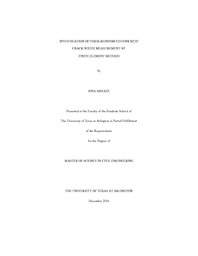
ATTENTION: The works hosted here are being migrated to a new repository that will consolidate resources, improve discoverability, and better show UTA's research impact on the global community. We will update authors as the migration progresses. Please see MavMatrix for more information.
Show simple item record
| dc.contributor.advisor | Abolmaali, Seyedali | |
| dc.creator | Abhaee, Sina | |
| dc.date.accessioned | 2017-02-14T16:48:50Z | |
| dc.date.available | 2017-02-14T16:48:50Z | |
| dc.date.created | 2016-12 | |
| dc.date.issued | 2016-12-21 | |
| dc.date.submitted | December 2016 | |
| dc.identifier.uri | http://hdl.handle.net/10106/26446 | |
| dc.description.abstract | This study presents numerical and experimental investigations of flexural cracking, post-cracking strength, and fracture energy of the dry-cast synthetic fiber reinforced concrete (FRC). Notched and un-notched beams for two fiber volume fractions were tested under flexural loading based on the recommendations of RILEM TC 162-TDF and ASTM C1609. The crack profile in terms of crack propagation and crack width, was assessed, using the two-dimensional digital image correlation (2D DIC) technique. Images of the specimen’s surface were captured during the test, and, surface deformation field was obtained by means of 2D DIC analysis.
The nonlinear, 3D finite element method (FEM) modeling of the flexural tests was performed, using a concrete damage plasticity (CDP) model for concrete. An indirect numerical method was utilized to obtain the tensile softening behavior of the synthetic FRC. The post-cracking stress-crack width relationship was obtained using the CDP model and a numerical inverse analysis procedure. For this purpose, a piecewise function for the stress-crack width relationship was assumed to simulate the tensile softening behavior of the synthetic FRC. Experimental load–deflection curves were fitted through a numerical fitting procedure and post-crack tensile softening was obtained.
Numerical load-crack width responses were calculated and compared with experimental curves. Finally, the average fracture energy was calculated based on the obtained softening laws. Comparison of experimental data and numerical results suggest that the addition of synthetic fibers to the dry-cast concrete mixture increases the ductility, fracture energy and post-cracking strength of the concrete and provide crack width control. Integration of the tensile softening law and the CDP model can simulate the flexural behavior of the synthetic FRC. In addition, the numerical result can also provide the crack width data. | |
| dc.format.mimetype | application/pdf | |
| dc.language.iso | en_US | |
| dc.subject | Crack width measurement | |
| dc.subject | Digital image correlation | |
| dc.subject | DIC | |
| dc.subject | Finite element method | |
| dc.subject | Post-cracking | |
| dc.subject | Tension softening | |
| dc.subject | Synthetic fibers | |
| dc.subject | Fiber-reinforced concrete | |
| dc.title | INVESTIGATION OF FIBER-REINFORCED CONCRETE CRACK WIDTH MEASUREMENT BY FINITE ELEMENT METHOD | |
| dc.type | Thesis | |
| dc.degree.department | Civil Engineering | |
| dc.degree.name | Master of Science in Civil Engineering | |
| dc.date.updated | 2017-02-14T16:48:50Z | |
| thesis.degree.department | Civil Engineering | |
| thesis.degree.grantor | The University of Texas at Arlington | |
| thesis.degree.level | Masters | |
| thesis.degree.name | Master of Science in Civil Engineering | |
| dc.type.material | text | |
| dc.creator.orcid | 0000-0003-4396-1218 | |
Files in this item
- Name:
- ABHAEE-THESIS-2016.pdf
- Size:
- 9.035Mb
- Format:
- PDF
This item appears in the following Collection(s)
Show simple item record


